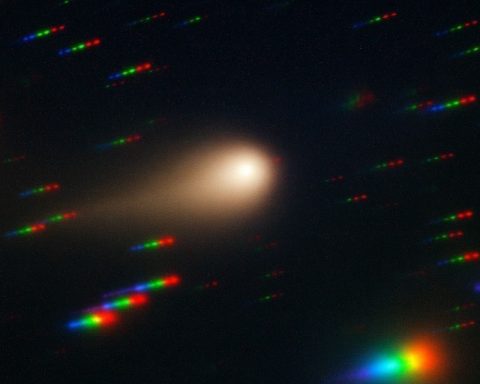- On July 23, 2025, NASA and SpaceX launched the TRACERS tandem-satellite mission from Vandenberg Space Force Base aboard a Falcon 9 rocket to study how solar eruptions trigger magnetic explosions in Earth’s atmosphere.
- The two TRACERS probes will fly seconds apart through Earth’s polar magnetic cusp to observe magnetic reconnection events in real time.
- TRACERS is expected to yield more than 3,000 measurements per year to map how solar storms drive auroras and radiation surges and improve space-weather forecasts for satellites, power grids, and astronauts.
- In winter 2024–25 in the UK, a study of 537 hospitalized babies found maternal RSV vaccination cut newborn hospitalizations by 72% when given at least two weeks before delivery.
- In February 2025, Svalbard experienced rain and blooming vegetation in winter as the archipelago warms 6–7 times faster than the global average.
- The February 2025 heat wave in Svalbard included 14 days with temperatures above 0°C, versus a historical average of -15°C.
- In Nature Communications on July 8, 2025, Aalto University researchers reported a superconducting transmon qubit with millisecond-scale coherence time, roughly doubling the previous ~0.5–0.6 ms record.
- A Canadian-led AI study found more than 86,000 previously unrecorded earthquakes beneath Yellowstone Caldera from 2008–2022, about ten times the size of the official catalog, as published in Science Advances.
- On July 14, 2025, Nature Communications published that two genes in zebrafish regulate inner-ear hair cell regeneration, enabling potential pathways to cure human deafness.
- Rice University and University of Houston researchers created a bio-derived, rotational bioreactor-grown cellulose nanofiber film from K. rhaeticus with tensile strength up to 436 MPa, 553 MPa with boron nitride, and heat conductivity three times better than regular cellulose.
Space & Astronomy
NASA Launches Twin Satellites to Probe Earth’s Magnetic Shield: On July 23, NASA (with SpaceX) successfully launched TRACERS, a tandem-satellite mission to study how the Sun’s eruptions spark magnetic explosions in Earth’s atmosphere. After a brief 1-day delay due to airspace issues, a Falcon 9 rocket carried the twin TRACERS spacecraft into orbit from Vandenberg Space Force Base [1]. The University of Iowa-led mission will fly the two probes just seconds apart through Earth’s polar magnetic cusp, where solar wind particles breach our magnetosphere, to observe how magnetic reconnection events unfold in real time [2] [3]. “NASA’s heliophysics fleet helps to safeguard humanity’s home in space and understand the influence of our closest star, the Sun,” said Dr. Joe Westlake, heliophysics division director at NASA Headquarters. “By adding TRACERS to that fleet, we will gain a better understanding of those impacts right here at Earth” [4]. Scientists say the data (3,000+ measurements in a year) will map how solar storms induce auroras and radiation surges, improving space-weather forecasts to protect satellites, power grids and astronauts [5] [6].
Medicine & Health
Maternal RSV Vaccine Dramatically Shields Newborns: A major UK study has found that vaccinating expectant mothers against RSV (respiratory syncytial virus) led to a “staggering 72% drop” in severe lung infections among their infants [7] [8]. Researchers tracked 537 babies hospitalized in winter 2024–25 (the first season of an RSV vaccine program) and discovered that mothers of healthy babies were far more likely to have received the new RSV jab than mothers of babies sick with RSV [9]. In fact, vaccination at least 2 weeks before delivery was most effective – cutting newborn hospitalizations by 72%, compared to about 58% protection from shots given later in pregnancy [10] [11]. By transferring protective antibodies through the placenta, the maternal vaccine shields infants through their first six months of life – the most vulnerable age. Yet only around half of pregnant women in the UK are currently getting the shot. “With the availability of an effective RSV vaccine shown to significantly reduce the risk of hospitalisation in young infants… there is an excellent opportunity for pregnant women to get vaccinated and protect themselves and their infants,” said Dr. Thomas Williams of the University of Edinburgh, the study’s lead author [12]. Health experts are urging greater uptake of this vaccine before the coming winter to prevent infant ICU admissions from RSV bronchiolitis [13].
Climate & Environment
Arctic Winter Turns to Rain, Shocking Scientists in Svalbard: A research team in the high Arctic got a surreal surprise this February – instead of the expected snow and subzero temps, they found rain, bare ground, and even blooming vegetation in the dead of winter [14] [15]. In a new Nature Communications commentary, Dr. James Bradley of Queen Mary University of London describes how his field crew arrived in Svalbard to encounter “exceptionally high temperatures, widespread snowmelt, and blooming vegetation” during what should be deep winter [16]. “Standing in pools of water at the snout of the glacier, or on bare, green tundra, was shocking and surreal,” Dr. Bradley said, recalling how an entire snowpack vanished within days amid unusual warmth and rain [17]. The archipelago of Svalbard is warming 6–7 times faster than the global average, the report notes, and mid-winter thaws that used to be rare are now regular features of a “profoundly altered” Arctic climate [18] [19]. The February 2025 heat wave saw temperatures swing above 0 °C on 14 days that month (versus an average of –15 °C historically) and rain falling where blizzards once ruled [20] [21]. Such winter warm spells can trigger permafrost collapse, disrupt ecosystems, and even raise safety issues for researchers and Indigenous communities. “We might have been too cautious with our messages. Irreversible changes to the Arctic climate are happening in front of our own eyes,” warned Dr. Donato Giovannelli, a co-author and geomicrobiologist in Italy [22]. The team is calling for urgent investment in cold-season monitoring and for climate policy to reckon with an Arctic that is thawing decades ahead of predictions [23] [24].
Physics
Quantum Computing Leap – Record Qubit Stability Achieved: Finnish physicists have shattered a key barrier in quantum technology by developing a qubit that stays coherent (stable) for about twice as long as any previous record [25] [26]. In results published July 8 in Nature Communications, researchers at Aalto University reported a superconducting transmon qubit with a coherence time reaching the millisecond range, whereas prior devices topped out around ~0.5–0.6 ms [27]. Longer coherence means a quantum bit can maintain its delicate quantum state through more operations before errors interfere [28]. “We have just measured an echo coherence time for a transmon qubit that landed at a millisecond… with a median of half a millisecond,” said Mikko Tuokkola, the PhD student who conducted the measurements [29]. Achieving this stability—by meticulously refining the materials and chip design—marks a major step toward fault-tolerant quantum computers that can solve problems beyond the reach of classical machines [30] [31]. The accomplishment also highlights Finland’s emergence as a quantum research leader. “This landmark achievement has strengthened Finland’s standing as a global leader in the field… moving the needle on what’s possible with the quantum computers of the future,” added Professor Mikko Möttönen, who heads the Quantum Computing and Devices group at Aalto [32] [33]. Next up, the team will focus on scaling up the number of qubits and further extending their lifetimes, bringing practical quantum computing closer to reality [34].
Artificial Intelligence
AI Reveals 86,000 ‘Hidden’ Earthquakes under Yellowstone’s Supervolcano: In a geophysical feat, scientists used machine learning to expose that Yellowstone’s volcano has been rumbling far more than anyone knew. By training an AI algorithm on 15 years of seismic data, a Canadian-led team uncovered over 86,000 previously unrecorded earthquakes beneath the Yellowstone Caldera (2008–2022) – 10 times more quakes than were in the official earthquake catalog [35] [36]. Most of these quakes were tiny (too small for humans to feel) and occurred in dense swarms along newly identified, shallow fault lines [37] [38]. The data, published in Science Advances, provide an unprecedented high-resolution view of the volcano’s hidden heartbeat and how pulses of magma and hot fluids trigger clusters of microquakes [39] [40]. “While Yellowstone and other volcanoes each have unique features, the hope is that these insights can be applied elsewhere,” said Professor Bing Li of Western University, the study’s lead author. “By understanding patterns of seismicity, like earthquake swarms, we can improve safety measures, better inform the public about potential risks and even guide geothermal energy development away from danger in areas with promising heat flow.” [41] [42]. The AI algorithm essentially did years’ worth of laborious seismic analysis in a fraction of the time, showing how machine learning is revolutionizing Earth science by mining vast data archives for missed events [43] [44]. Importantly, researchers emphasize that Yellowstone’s increased quake count does not signal an impending eruption – rather, it gives experts a much fuller baseline for monitoring the volcano’s natural activity and subtle changes over time [45] [46].
Biology
Zebrafish Regrow Inner-Ear Cells, Offering Clues for Curing Deafness: In a breakthrough study, biologists have decoded the genetic trick that lets zebrafish restore damaged hearing cells – an ability that mammals (including humans) tragically lack. The tiny hair cells of the inner ear are vital for hearing and balance; once destroyed by loud noise or aging, humans cannot replace them, often leading to permanent hearing loss. “Mammals such as ourselves cannot regenerate hair cells in the inner ear,” explained Dr. Tatjana Piotrowski of the Stowers Institute, a senior author on the new study. “As we age or are subjected to prolonged noise exposure, we lose our hearing and balance” [47]. By contrast, zebrafish (along with some birds and amphibians) can regrow these sensory cells throughout their lives. Now, writing in Nature Communications (July 14), Piotrowski’s team reports finding two specific genes that enable zebrafish’s ear regeneration [48] [49]. Each gene controls a different population of support cells in the inner ear: one gene keeps a reservoir of stem-like cells ready, while the other gene triggers those cells to proliferate and turn into new hair cells when needed [50] [51]. By genetically tweaking each gene separately, the scientists showed that the regeneration pathway can be split into two independent steps [52] [53]. “This finding shows that different groups of cells within an organ can be controlled separately,” Dr. Piotrowski said. This insight suggests it may be possible to “flip the switch” in human ears by activating one pathway at a time – for example, via gene therapy or drugs – to spur the regrowth of our own hair cells [54] [55]. Though such a treatment is still far off, uncovering these regenerative genes in fish is a crucial first step toward future hearing loss cures that were long thought impossible.
Technology & Engineering
“Supermaterial” from Bacteria Could Spell the End of Plastic: In a green manufacturing feat, engineers have persuaded microbes to produce a biodegradable material as strong as metal. A team from Rice University and University of Houston developed a method to coax common bacteria (K. rhaeticus) into spinning out highly aligned cellulose nanofiber sheets with remarkable properties [56] [57]. Normally, these bacteria produce cellulose in a jumbled mesh. But by growing them in a specially designed rotational bioreactor, the researchers “trained” the microbes to orient their cellulose fibers all in one direction – essentially converting a squishy biofilm into a transparent film with the strength of aluminum alloys or even steel [58] [59]. The resulting bionanocomposite is not only extremely strong (tensile strength measured up to ~436 MPa, and ~553 MPa when reinforced with boron nitride, rivaling some steels) but also lightweight, flexible, and entirely compostable [60] [61]. It also conducts heat three times better than regular cellulose, which could be useful for cooling electronics [62]. “Our approach involved developing a rotational bioreactor that directs the movement of cellulose-producing bacteria, aligning their motion during growth,” explained M.A.S.R. Saadi, first author of the study [63]. This single-step, scalable process can even integrate other nanomaterials on the fly to customize the film’s properties [64]. “This work is a great example of interdisciplinary research at the intersection of materials science, biology and nanoengineering,” said Dr. Muhammad Rahman, the project lead. He added that the strong, eco-friendly bacterial cellulose sheets could “become ubiquitous, replacing plastics in various industries and helping mitigate environmental damage.” [65] With plastic pollution persisting worldwide, such bio-derived supermaterials offer a tantalizing route to sustainable packaging, textiles, electronics, and more – grown from bacteria instead of oil [66] [67].
Sources: The information and quotes in this report come from peer-reviewed research publications and official press releases or news outlets, including NASA [68] [69], The University of Edinburgh [70] [71], Queen Mary University of London/ScienceDaily [72] [73], Aalto University [74] [75], University of Western Ontario/ScienceDaily [76] [77], Stowers Institute for Medical Research [78] [79], and Rice University [80] [81]. Each linked citation provides access to the original source for further details.
References
1. www.nasa.gov, 2. www.nasa.gov, 3. www.nasa.gov, 4. www.nasa.gov, 5. www.nasa.gov, 6. www.nasa.gov, 7. www.ed.ac.uk, 8. www.nationalhealthexecutive.com, 9. www.ed.ac.uk, 10. www.ed.ac.uk, 11. www.ed.ac.uk, 12. www.ed.ac.uk, 13. www.ed.ac.uk, 14. www.sciencedaily.com, 15. www.sciencedaily.com, 16. www.sciencedaily.com, 17. www.sciencedaily.com, 18. www.sciencedaily.com, 19. www.sciencedaily.com, 20. www.nature.com, 21. www.nature.com, 22. www.sciencedaily.com, 23. www.sciencedaily.com, 24. www.sciencedaily.com, 25. scitechdaily.com, 26. scitechdaily.com, 27. scitechdaily.com, 28. scitechdaily.com, 29. scitechdaily.com, 30. ts2.tech, 31. scitechdaily.com, 32. ts2.tech, 33. scitechdaily.com, 34. ts2.tech, 35. www.sciencedaily.com, 36. www.sciencedaily.com, 37. www.sciencedaily.com, 38. www.sciencedaily.com, 39. www.sciencedaily.com, 40. www.sciencedaily.com, 41. www.sciencedaily.com, 42. scitechdaily.com, 43. www.sciencedaily.com, 44. www.sciencedaily.com, 45. scitechdaily.com, 46. www.sciencedaily.com, 47. scitechdaily.com, 48. scitechdaily.com, 49. scitechdaily.com, 50. scitechdaily.com, 51. scitechdaily.com, 52. scitechdaily.com, 53. scitechdaily.com, 54. scitechdaily.com, 55. scitechdaily.com, 56. news.rice.edu, 57. news.rice.edu, 58. news.rice.edu, 59. news.rice.edu, 60. news.rice.edu, 61. news.rice.edu, 62. news.rice.edu, 63. news.rice.edu, 64. news.rice.edu, 65. news.rice.edu, 66. news.rice.edu, 67. news.rice.edu, 68. www.nasa.gov, 69. www.nasa.gov, 70. www.ed.ac.uk, 71. www.ed.ac.uk, 72. www.sciencedaily.com, 73. www.sciencedaily.com, 74. scitechdaily.com, 75. scitechdaily.com, 76. www.sciencedaily.com, 77. scitechdaily.com, 78. scitechdaily.com, 79. scitechdaily.com, 80. news.rice.edu, 81. news.rice.edu










